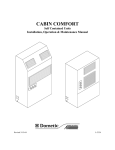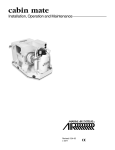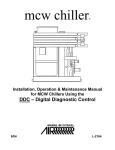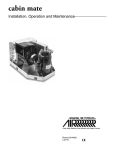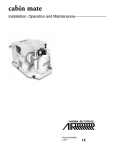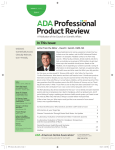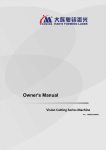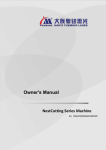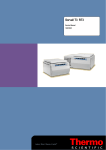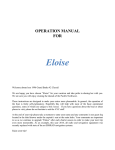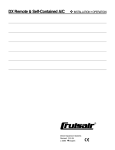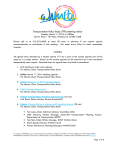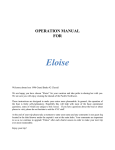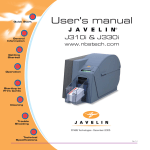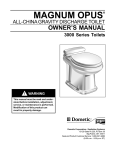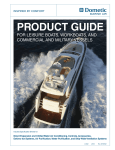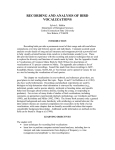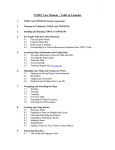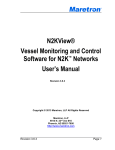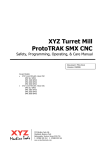Download Operation, Installation & Maintenance
Transcript
Operation, Installation & Maintenance 7/02 L-2168 PREFACE Congratulations on the purchase of your Marine Air Systems’ VECTOR COMPACT® air conditioner. No matter which of the following features was the reason for your purchase of this air conditioner, we are sure it will meet your needs and will give you many years of efficient and trouble free use. The Vector Compact self-contained direct expansion air conditioners are designed for marine applications incorporating the following features: • • • • • • • • • Patented compact design with the condenser coil in the evaporator shroud High efficiency rotary compressor (7-16K) or scroll (24K) compressors Cupronickel condenser coil Raised lance fin designed evaporator coil Polyurethane coated 2” deep drain pan with multiple condensate drain locations Anti-vibration base pan Pre-charged and pre-wired systems for easy connections Rotatable blower assembly Charge Guard® ensures environmental protection and system integrity The PASSPORT® II micropressor based digital controller, optional with this unit, offers the most technologically advanced design specifically made for the unique requirements of marine air conditioning. The controller has been designed with flexibilty and the following “user friendly” features customers require for their applications: • Non-volatime memory • Program lock prevents accidental program tampering • Low voltage display panel • Face plate air sensor for accurate temperature control, or optional remote sensor • LED cabin temperature displayed in Fahrenheit or Celsius • Multiple fan speed selections with high and low limits • User selected programs for optimum control • Optional outside air temperature sensor • Compressor pressure failsafe protection and run time hour meter • Compressor start staging delay for multiple a/c systems • Moisture mode cycle for humidity control • De-icing feature to prevent evaporator icing • Blank display for nighttime operation This manual is intended to provide the information necessary to ensure proper installation, operation, and maintenance of the unit. Improper installation or misunderstood operating procedures can result in unsatisfactory performance and/or premature failure of these units, so before proceeding please read this manual completely. The Vector Compact® units are covered under the existing Taylor Made Environmental, Inc. warranty policy contained in this manual. In the interest of product improvement, Taylor Made Enviornmental’s specifications and design are subject to change without prior notice. REVISION HISTORY Document Name: vectorcompact Original Print: March 1998 Revised: 5/98, 7/98, 11/98, 11/01, & 7/02 ®Taylor★Made is a registered trademark of Nelson A. Taylor Co., Inc; The Marine Air Systems logo, Vector Compact, Charge Guard, and Passport are registered trademarks and the Taylor Made Environmental logo is a trademark of Taylor Made Environmental, Inc. CLEAN AIR ACT AMENDMENTS OF 1990 [TITLE VI - SECTION 608(C-1)] “Effective July 1, 1992, it shall be unlawful for any person, in the course of maintaining, servicing, repairing, or disposing of an appliance or industrial process refrigeration, to knowingly vent or otherwise knowingly release or dispose of any Class I* or Class II** substance used as a refrigerant in such appliance (or industrial process refrigeration) in a manner which permits such substance to enter the environment. De minimis releases associated with good faith attempts to recapture and recycle or safely dispose of any such substances shall not be subject to the prohibition set forth in the proceeding sentence.” *Class I substances include CFC-12 **Class II substances include HCFC-22 MARINE AIR SYSTEMS Marine Air Systems (MAS) is a product of Taylor Made Environmental, Inc (TME). TME is a recognized leader in the design and manufacture of high-performance comfort control systems, refrigeration products and battery charging products for demanding environments, including commercial and recreational marine craft, vehicles and other applications. We offer an unparalleled scope of products, dealer networks, applications support, engineering resources and production capabilities throughout the world. Our team has many years of experience in the design, manufacture, application and support of our products. Our practical experience and design capability allows our application engineers and sales representatives to offer optimum solutions for your environmental control requirements. Product lines also include well known Cruisair, Grunert, and Sentry. TME is a Member of the Taylor Made Group. OVERVIEW HOW IT WORKS: Your self-contained air conditioner consists of four main components and a refrigerant gas circulating through the system. The BLOWER draws warm cabin air across the fins on the EVAPORATOR where the heat from the air is transferred to the refrigerant in the evaporator coil. As the refrigerant evaporates from a liquid into a gas it absorbs the heat from the cabin air. The COMPRESSOR then compresses the refrigerant gas and pumps it through the outer tube in the CONDENSER COIL. The seawater pump circulates cool seawater through the inner tube in the condenser coil, this cools the refrigerant and condenses it into a liquid. The heat from the refrigerant is exchanged to the seawater and discharged overboard. The liquid refrigerant is then passed through the EVAPORATOR COIL and the cycle repeats. Removing heat from the cabin air lowers its temperature. The cooled air is blown through the ducting and out the supply air grille(s). For reverse cycle heating, the refrigerant flows in the opposite direction through the reversing valve. Heat is transferred from the seawater in the condenser coil to the refrigerant and then to the air blowing through the evaporator into the cabin. Seawater temperature will directly affect the a/c unit’s efficiency. This a/c unit can effectively cool your boat in water temperatures up to 90oF and heat in water temperatures as low as 40oF. Vector Compact® 4 TABLE OF CONTENTS INSTALLATION Unpacking and Inspection Safety Considerations Placement of System (Tools Required) Spacing Allowances & Unit Dimensions Condensate Drains Blower Assembly Mounting Brackets Supply & Return Air Grilles and Transition Boxes Ducting Seawater Pump and Plumbing Electrical Connections, Grounding, Bonding & ABYC standards 3 Phase Notice Manual Control Panel (MCP) Installation Passport II Display Panel Installation Installation Checklist (review prior to and after installation) Vector Compact Mechanical Control (VCM) Wiring Diagrams Vector Compact Passport II Digital Control (VCP) Wiring Diagrams 6 6 7 8 9 9 9 10 10 11 12 12 13 14 15 16 17 OPERATION Manual Control Panel (MCP) Operation Quick Start Operations Checklist Passport®II Control Modes of Operation Programming the Passport®II Programming Notes General Troubleshooting Guidelines Passport®II Digital Control Troubleshooting Guidelines MCP Mechanical Control Panel Troubleshooting Guidelines 13 15 18 18,19 19-22 22 23, 24 25, 26 26 MAINTENANCE Reversing Valve, Seawater System, Blowers, Condensing Coil Cleaning, Return Air Filters, Winterization Manufacturers Limited Warranty Agreement Distributor Listing 27 29 31 Vector Compact® 5 INSTALLATION UNPACKING AND INSPECTION When the equipment is received, all items should be carefully checked against the packing list to ensure all cartons have been received. Move units in the normal “up” orientation as indicated by the arrows on each carton. Examine cartons for shipping damage, removing the units from the cartons if necessary. If the unit is damaged, the carrier should make the proper notation on the delivery receipt acknowledging the damage. CAUTION: When unpacking and installing the 2 knob control (if mechanical option is used), care must be taken not to kink or break the copper cap tube when uncoiling the sensing bulb. The cap tube is hollow and kinking or sharp bends will inhibit system operation. SAFETY CONSIDERATIONS VERY IMPORTANT: Never install your air conditioner in the bilge or engine room areas. Insure that the selected location is sealed from direct access to bilge and/or engine room vapors. Do not terminate condensate drain line within three (3) feet of any outlet of engine or generator exhaust systems, nor in a compartment housing an engine or generator, nor in a bilge, unless the drain is connected properly to a sealed condensate or shower sump pump. Installation and servicing of this system can be hazardous due to system pressure and electrical components. When working on this equipment, always observe precautions described in the literature, tags and labels attached to the unit. Follow all safety codes. Wear safety glasses and work gloves and place a fire extinguisher close to the work area. The following is a summary of the labels on the unit: ! DANGER ELECTRICAL SHOCK HAZARD. DISCONNECT VOLTAGE AT MAIN PANEL OR POWER SOURCE BEFORE OPENING ANY COVER. FAILURE TO COMPLY MAY RESULT IN INJURY OR DEATH. ! WARNING THIS COMPONENT DOES NOT MEET FEDERAL REQUIREMENTS FOR IGNITION PROTECTION. DO NOT INSTALL IN SPACES CONTAINING GASOLINE ENGINES, TANKS, LPG/CPG CYLINDERS, REGULATORS, VALVES OR FUEL LINE FITTINGS. FAILURE TO COMPLY MAY RESULT IN INJURY OR DEATH NOTICE THIS COMPONENT IS CHARGED WITH HYDROCHLOROFLUOROCARBON (HCFC) REFRIGERANT R22. EFFECTIVE JULY 1, 1992 IT SHALL BE UNLAWFUL FOR ANY PERSON TO KNOWINGLY VENT OR OTHERWISE KNOWINGLY RELEASE ANY CLASS 1 (CFC) OR CLASS 2 (HCFC) SUBSTANCE AS A REFRIGERANT IN A MANNER WHICH PERMITS SUCH SUBSTANCE TO ENTER THE ATMOSPHERE PER THE CLEAN AIR ACT OF 1990. PUBLIC LAW 101-549 TITLE IV SECTION 608-C. FAILURE TO COMPLY MAY RESULT IN SEVERE PENALTIES, INCLUDING FINES AND IMPRISONMENT. ! WARNING TO MINIMIZE THE HAZARD OF ELECTRICAL SHOCK AND PERSONAL INJURY, THIS COMPONENT MUST BE EFFECTIVELY GROUNDED. REFER TO THE INSTALLATION GUIDELINES FOR FURTHER INFORMATION. CAUTION! HIGH COMPRESSOR TEMPERATURE IS NORMAL DO NOT TOUCH Vector Compact® 6 PLACEMENT OF SYSTEM Selecting a good location for your air conditioner is the most important part of your preparations. Be sure to consider the size of the area you are cooling, the air distribution needs, and the size of the unit you have chosen. Keeping in mind that cool air has a tendency to fall, it is highly recommended that you locate the supply air grille as high as possible in the cabin. See diagram below. The VECTOR COMPACT unit should be installed as low as possible, BUT NEVER IN THE BILGE OR ENGINE ROOM AREAS. INSURE THAT THE SELECTED LOCATION IS SEALED FROM DIRECT ACCESS TO BILGE AND/OR ENGINE ROOM VAPORS. Installing the unit as low as possible (such as under a V-berth, dinette seat or bottom of a locker) and ducting the supply air as high as possible, creates an ideal air flow condition. This type of installation will prevent short or premature cycling. The unit should be positioned on a firm, level, horizontal surface and the condensate drain line should run downward from the unit to a suitable drain location. Plan all connections which must be made including ducting, condensate drain, seawater in and out, electrical power connections, location of control, and seawater pump placement, to assure easy access for routing and servicing. Vector Compact® 7 Tools required • • • • • • • • • • • Screws drivers Pliers Pipe wrench Wire cutters/crimpers Drill & 7/8” bit Jig saw Duct tape Electrical tape Teflon tape Beding compound to seal thru hull fittings Hardware to secure unit, pump, strainer, grilles & control panel Vector Compact® 8 CONDENSATE DRAINS The condensate drain pan is 1¾” high with four drain locations. During conditions of high humidity, condensate may be produced at a rate of approximately ½ gallon per hour. With this in mind, it is important to route condensate drains downward to a sump pump. It is not recommended to route condensate drains to the bilge. After the condensate drain installation is complete, test the installation by pouring a quart of water into the pan and checking for good flow. For installation of the condensate drain: 1. Remove the aft facing watertight plug from the base pan of the a/c unit. 2. Slip the solid washer and the liquid-seal washer onto the PVC fitting in that order. 3. Connect the fitting through the exposed hole in the base pan with the locking nut. 4. Securely tighten with two (2) wrenches to provide a proper seal. 5. Attach a 5/8” I.D. reinforced hose to the hose barb and secure with stainless steel hose clamps. 6. Install the condensate drain hose downhill from the unit and aft to a sump. 7. Two drain fittings may be used and the hoses teed together provided there is a minimum 2" drop form the bottom of the base pan to the tee connection. NOTE: DO NOT TERMINATE CONDENSATE DRAIN LINE WITHIN THREE (3) FEET OF ANY OUTLET OF ENGINE OR GENERATOR EXHAUST SYSTEMS, NOR IN A COMPARTMENT HOUSING AN ENGINE OR GENERATOR, NOR IN A BILGE, UNLESS THE DRAIN IS CONNECTED PROPERLY TO A SEALED CONDENSATE OR SHOWER SUMP PUMP. BLOWER ASSEMBLY With the VECTOR COMPACT® you can achieve multi-directional supply air discharge from a single unit by rotating the blower to the desired location. It is ideal for tight installations as 130o of rotation are available with which to position the blower. Its advanced design allows the blower to be easily removed for rotating or servicing by releasing a single stainless steel clamp and two (2) mounting ring screws. Rotate the blower to allow the most direct flow of air to the supply air grille. MOUNTING BRACKETS The a/c unit is supplied with a base pan that also serves as a condensate pan. Mounting clip brackets and screws (4) are provided to secure the base pan onto a flat, horizontal surface. Vector Compact® 9 SUPPLY & RETURN AIR GRILLES AND TRANSITION BOXES Install the supply air grille as high as possible in a location that will provide uniform air distribution throughout the cabin, grille louvers should be directed upward. The return air grille should be installed as low and close to the a/c unit as possible to insure direct uninteruppted airflow to the evaporator. The return air grille should have a minimum four inches (4”) of clearance in front of it, free from any furniture or other obstructions. In no instance should a supply air discharge be directed towards a return air grille, as this will cause the system to short cycle. Allow for adequate clearance behind the supply air grille(s) for the transition box and ducting connection. The following table shows minimum grille sizes. See the MAINTENANCE section of this manual for return air filter cleaning instructions. DUCTING Good airflow is critical for the performance of the entire system. It is highly dependent on the quality of the ducting installation. The ducting should be run as straight, smooth and taut as possible minimizing the number of 90 degree bends (two tight 90 degree bends can reduce airflow by 25%). The following table shows minimum duct diameters and their corresponding supply and return air grille minimum area in square inches. If a transition box is used, the total area of supply air ducts going out of the box should at least equal the area of the supply duct feeding the box. To calculate the square inch area of a round duct, multiply the radius by itself (r2) and multiply that number by 3.1416(π). MODEL 5K 7K 10K 12K 16K 24K 4" dia. 5" dia. 6" dia 6" dia 7" dia 8" dia DUCT AREA 12.6 sq in 19.6 sq in 28.3 sq in 28.3 sq in 38.5 sq in 50.3 sq in R/A GRILLE 64 sq in 88 sq in 120 sq in 140 sq in 168 sq in 280 sq in S/A GRILLE 30 sq in 40 sq in 60 sq in 70 sq in 84 sq in 140 sq in DUCT DIA The following is a summary of proper ducting connections: 1. Pull back the fiberglass insulation exposing the inner mylar duct hose. 2. Slide the mylar duct hose around the mount ring until it bottoms out. 3. Screw 3 or 4 stainless steel sheet metal screws through the duct hose into the transition ring. Make sure to catch the wire in the duct hose with the heads of the screws. Do not use band clamps, as the hose will slide off. 4. Wrap duct tape around the ducting and ring joint to prevent any air leaks. 5. Pull the insulation back up over the mylar to the ring and tape this joint. 6. Remove excess ducting and use the same connection method at the supply air grille. All ducting should: • Be appropriately sized for each application. • Run as smoothly and taut as possible. • Have as few bends or loops as possible. • Be securely fastened to prevent sagging during boat operation. • Have all excess ducting lengths trimmed off. • Not be flattened or kinked. • Insulated when located in high heat load areas (hull side, mechanical compartments, etc.). • Be properly protected against potential damage when routed through open areas. Vector Compact® 10 SEAWATER PUMP AND PLUMBING Several guidelines should be followed during the installation of the seawater system. Since the circulation pump is centrifugal and not self-priming, it must be mounted so that it is always at least one foot below the water line regardless of which tack the vessel is on. Pump may be mounted horizontally or vertically, however the discharge must always be above the inlet. Pump head should be rotated toward the direction of water flow. Install the seawater speed scoop intake as far below the water line and as close to the keel as possible in any application, but especially on a sailboat, to keep the intake in the water when the boat heels over so that air does not get into the system. The speed scoop intake must face forward and not be shared with any other pump. A seawater strainer is mandatory between the shut off valve (seacock) and the pump to protect the pump from any foreign matter. Failure to install a seawater strainer will void the pump warranty. The seawater system should be installed with an upward incline from the speed scoop & seacock, through the strainer, to the inlet of the pump and then up to the inlet of the a/c unit’s condenser coil. The discharge from the a/c unit should then run to the seawater outlet thru-hull fitting which should be located where it can be visually checked for water flow and as close as practicable to the waterline to reduce noise. All hose connections shall be secured by means of double/reversed stainless steel hose clamps. Use teflon tape on all threaded connections. The following is a summary of the seawater system installation: 1. Install the speed scoop thru-hull inlet as close to the keel and as far below the water line as possible, facing forward. Bed the scoop with a marine sealant designed for underwater use. 2. Install a bronze, full flow seacock on the speed scoop thru-hull inlet. 3. Install a seawater strainer below the level of the pump with access to filter. 4. Mount the pump above the strainer and at least one foot below the waterline. 5. Connect the seacock and strainer with an uphill run of 5/8" reinforced marine grade hose. 6. Connect the discharge from the pump uphill to the bottom inlet of the a/c unit’s condenser coil with 5/8" hose. Connect the discharge from the condenser coil to the overboard discharge thru-hull fitting with 5/8" hose. 7. Avoid loops, high spots or the use of 90º elbows with seawater hose (each 90º elbow is equivalent to 2.5' of hose and a 90º elbow on the pump outlet is equivalent to 20' of hose). 8. Double clamp all hose connections with stainless steel clamps, reversing the clamps. 9. Use teflon tape on all threaded connections. 10. Connect all metallic parts in contact with seawater to the vessel’s bonding system including the speed scoop inlet, strainer, pump and the air conditioner. Failure to do so will void warranty. Vector Compact® 11 ELECTRICAL CONNECTIONS, GROUNDING AND BONDING All a/c units have a terminal strip mounted inside the electric box. The terminal strip is labeled for proper connections of the electrical supply, ground wires and pump circuits. A wiring diagram is provided in the electrical box and in this manual. The wiring diagram in the elcetrical box supersedes the one in this manual and ABYC standards. The correct size circuit breaker should be used to protect the system as specified on the a/c unit’s data plate label. A minimum of 12 AWG boat cable should be used to supply power to the a/c unit and the seawater pump. All connections shall be made with ring or fork terminals. Turn off a/c power supply circuit breaker before opening electric box. Each a/c unit installed requires its own dedicated circuit breaker. If there is only one a/c unit installed, the seawater pump does not require a circuit breaker; the wiring from the seawater pump is connected to the terminal strip in the electric box. If two or more a/c units use the same seawater pump, the pump wires will be connected to a pump relay panel (PRP) which in turn has its own dedicated circuit breaker sized for the pump (20 amp max). Please see the wiring diagram furnished with the PRP (NOTE: PRP triac must have its mounting screw installed in order to dissipate heat). Electrical connections in the bilge and/or below the waterline should use heat shrink type butt splices. Field wiring must comply with ABYC electrical codes. Power to the unit must be within the operating voltage range indicated on the data plate. Properly sized fuses or HACR circuit breakers must be installed for branch circuit protection. See data plate for maximum fuse/circuit breaker size (mfs) and minimum circuit ampacity (mca). All units must be effectively grounded to minimize the hazard of electrical shock and personal injury. The following are to be observed: 1. AC (alternating current) grounding (green wire) must be provided with the AC power conductors and connected to the ground terminal (marked “GRND”) at the AC power input terminal block of the unit(s), per ABYC standard E-8, or equivalent. 2. Connections between the vessel’s AC system grounding conductor (green wire) and the vessel’s DC (Direct Current) negative or bonding system should be made as part of the vessel’s wiring, per ABYC standard E-9, or equivalent. 3. When servicing or replacing existing equipment that contains a chassis-mounted ground stud, the service person or installer must check the vessel’s wiring for the existence of the connection required in item 2 above. ABYC standards are available from: American Boat and Yacht Council, 3069 Solomons Island Rd. Edgewater, MD 21036 Telephone: (410) 956-1050 The a/c unit must be connected to the ship’s bonding system to prevent corrosion due to stray electrical current or voltage. All pumps, metallic valves and fittings in the seawater circuit that are isolated from the a/c unit by PVC or rubber hoses must be individually bonded to the vessels bonding system also. This will help eliminate any possibility of corrosion due to stray current or voltage. FAILURE TO PROPERLY GROUND AND BOND THE SYSTEM WILL VOID WARRANTY! 3 PHASE NOTICE It is extremely important to insure that wiring and phase sequencing of a three phase power source is correct. Marine wiring standards call for power source phases L1, L2, and L3 to be color-coded BLACK, WHITE, and RED, respectively. These must be connected to the unit with the proper sequence, otherwise, it will not operate properly. If the wiring sequence is incorrect, the unit’s compressor (Scroll type only) and pump (if applicable) will run in the reverse direction at a significantly increased noise level. Vector Compact® 12 MANUAL CONTROL PANEL (MCP) INSTALLATION The MCP should be located within cap tube length of the a/c unit. The 3 knob MCP is configured either vertically (shown) or horizontally. The cut out size is 2.5” by 7.0”, see MCP for orientation. Once the cut out is made, carefully uncoil the copper cap tube with return air sensor (copper bulb) and route the control wires and cap tube through the hole and back to the a/c unit using caution not to kink the cap tube. Mount the return air sensor into the clips provided on the evaporator coil. If the return air sensor cannot be mounted on the evaporator coil, mount it behind the return air grille. The sensor must be mounted in the return air stream. Make electrical connections according to the wiring diagram found in the electric box and/or in the operations manual. MCP OPERATION 1) Ensure seawater intake ball valve (sea cock) is open. 2) Turn SYSTEM SWITCH control knob to OFF. 3) Turn on AC circuit breaker. If the seawater pump has its own circuit breaker, turn that on too. 4) Turn the SYSTEM SWITCH control knob to START; this energizes the fan and seawater pump. Turn THERMOSTAT control knob to the coolest position by rotating fully clockwise. If system has reverse cycle, turn knob counter-clockwise for heat. 5) Check for a steady solid stream of seawater from the overboard discharge. 6) Turn FAN SPEED control knob clockwise to highest setting. 7) Verify that the fan is running and that there is steady airflow out of the supply air grille. 8) Turn the SYSTEM SWITCH to RUN; this will start the compressor. The indicator light on the control will illuminate. 9) To set the thermostat, allow sufficient time for the unit to cool/ heat the area to the desired temperature. When the area is sufficiently cooled/heated, turn the thermostat knob slowly toward the center position until it clicks once (the indicator light will turn off). The thermostat is now set to maintain a constant temperature. While heating, if the ambient temperature is less than 500F, set the FAN SPEED control knob to low for five to ten minutes until the unit begins to heat well, then increase the fan speed for more heat output. The thermostat on the MCP control panel serves to cycle the compressor on and off and provide an automatic changeover from cooling to heating (reverse cycle only) with a 3.5( differential. Rotating the thermostat to the left after it has been set for cooling will cause the unit to heat. If you rotate the thermostat to the right, the unit will cool. If the thermostat is left stationary after being set, the unit will cycle from cooling to neutral, or heating to neutral depending on the requirement. Reverse cycle units have a reversing valve that must be energized periodically to keep the internal parts moving freely. To accomplish this, switch the A/C into HEAT for a few seconds once a month. Note: Do not turn the unit off and immediately turn it back on. Wait at least 30 seconds. Vector Compact® 13 PASSPORT II DISPLAY PANEL INSTALLATION Before mounting the Passport II digital display panel touch pad, consider the location. The air sensor built into the display panel will provide excellent room air temperature sensing given a proper installation. The display panel should be mounted on an inside wall, slightly higher than mid-height of the cabin, in a location with freely circulating air where it can best sense average temperature. The cut out size for the display panel is 3” wide by 2”( high. Do not mount the display in direct sunlight, near any heat producing appliances or in a bulkhead where temperatures radiating from behind the panel may effect performance. Do not mount the display in the supply air stream. Do not mount the display above or below a supply or return air grille. Do not mount the display behind a door, in a corner, under a stairwell or any place where there is no freely circulating air. Mount the display within display cable length (custom lengths available) of the air conditioner. Plug the display cable (15”/4.6m standard length with 8-pin connector) into the circuit board in the electric box and into the back of the display panel. Secure the display panel to a bulkhead with the adhesive strips provided. Clean the mounting surface with isopropyl alcohol only prior to placement (test alcohol on hidden portion of surface first). If the adhesive strips cannot be used directly on the bulkhead then use the plastic bulkhead adapter. The bulkhead adapter (sold separately) is mounted to the bulkhead with screws and the display panel is secured to the adapter with adhesive strips. Do not use a screw gun and do not over-tighten screws when mounting adapter. If a proper location for room temperature sensing cannot be found for the display, an optional remote air sensor may be used. Mount the remote air sensor in the return air stream behind the return air grille opening and plug its cable (7’/2.1m standard length with 6-pin connector) into socket #J2 on the circuit board (socket nearest the corner of the board). Installing the remote air sensor will override the face plate sensor. An optional outside air temperature (O.A.T.) sensor and cable may also be used. Plug the O.A.T. cable into the 6-pin socket #J3. Mount the sensor outside in a protected location and not in direct sunlight. Air sensor cables are available in various lengths. Secure all cables but do not staple when mounting. Vector Compact® 14 INSTALLATION CHECKLIST (review prior to installation) Seawater cooling system: ❍ Speed scoop located as far below the water line and as close to the keel as possible ❍ Shut off valve (sea cock) and speed scoop properly sealed and tight ❍ Seawater pump is at least one foot below water line and securely mounted ❍ Strainer mounted below pump with access to filter ❍ Double/reversed stainless steel hose clamps on all hose connections ❍ Teflon tape on all threaded connections ❍ Hose runs uphill from speed scoop and sea cock to strainer, pump and a/c unit, then downhill (if possible) from a/c unit to overboard discharge ❍ Water flowing freely from overboard discharge while pump is running ❍ Pump relay panel, if used, must have its own circuit breaker sized for the pump (20 amp max) ❍ All metal fittings should be bonded Mounting ❍ Not in engine room or bilge areas, must be sealed away from exhaust or fumes ❍ Proper spacing allowed around unit ❍ Attached to solid level platform with hold down clips provided ❍ Condensate drain routed aft and down hill to a sealed sump (not bilge) ❍ Blower rotated toward supply air grille Electrical ❍ All butt connections on pumps wire tightly crimped and heat shrunk ❍ AC power source installed and grounded/bonded in accordance with ABYC standards ❍ Control wires connected to terminal strip with fork or ring terminals ❍ Circuit breakers sized according to specifications on the data plate label ❍ Passport II display cable is connected at both ends ❍ Pump Relay Panel (if used) has a dedicated circuit breaker sized for the pump but not to exceed 20 amps maximum. Grilles and Ducting ❍ Supply air grille mounted as high as possible ❍ Return air grille mounted as low and as close to the a/c unit as possible ❍ Return air grille mounted away from bilge vapors or exhaust fumes ❍ Ducting is pulled taut, straight, smooth and properly connected with no excess QUICK START OPERATIONS CHECKLIST ❍ ❍ ❍ ❍ ❍ ❍ ❍ Ensure seawater intake ball valve (sea cock) is open. Turn on the a/c circuit breaker. If the seawater pump has its own circuit breaker, turn that on. Turn the system on. Set the desired cabin temperature (set point). Check for a steady solid stream of water from the overboard discharge. Verify that there is steady airflow out of the supply air grille. If the unit does not appear to be operating properly, refer to troubleshooting guide lines. Note: Do not turn the unit off and immediately turn it back on. Allow at least 30 seconds for refrigerant pressure equalization. Vector Compact® 15 Vector Compact® 16 Vector Compact® 17 PASSPORT II CONTROL POWER BUTTON: Press and release to turn unit on and off. NOTE: To “press and release” a button, press and hold for one second and then release. FAN BUTTON: Press and hold until the letter “A” appears for automatic fan speed or the numbers “1” (slow) through “6” (fast) appear for manual fan speed. Fan may be used while a/c is off. UP & DOWN BUTTONS: Press and hold either button until desired temperature (set point) is displayed. Press either button momentarily to show current set point. Range = 600-850F. COOL LED: Lights when the compressor is running in cool mode or in automatic mode while cooling. FAN LED: Lights when fan is on in manual mode. HEAT LED: Lights when the compressor is running in heat mode, or automatic mode while heating. DISPLAY WINDOW: Shows current cabin temperature. It can also show outside air temperature if the optional O.A.T. sensor is installed. Also used in viewing and setting program parameters. AIR SENSOR: Cabin temperature is detected by the face plate air sensor, located in the bottom edge of the display. A remote air sensor can be installed if needed. Installing the remote air sensor will override the face plate sensor. BLANK DISPLAY FOR NIGHTTIME OPERATION: Press the FAN and DOWN buttons simultaneously to blank the display for nighttime operation. The appropriate LEDs will remain lit during cooling and heating. When the desired temperature has been achieved, the middle segment of the display window will remain lit to indicate that the system is on. Press any button to return to normal display mode. OUTSIDE AIR TEMPERATURE: When the optional outside air sensor is installed, press the UP and DOWN buttons simultaneously to display the outside air temperature. The outside air sensor should not be mounted in direct sunlight. MODES OF OPERATION COOL ONLY MODE: When the Passport II is configured for cool only mode, only cooling systems will be operated as required. When the temperature drops below the set point the system will not automatically switch into the heating mode. HEAT ONLY MODE: When the controller is programmed for heating mode, only the heating system will be selected for operation as required. Should the temperature rise above the set point the system will not switch to the cooling mode automatically. AUTOMATIC MODE: When the controller is configured for the automatic mode, both heating and cooling will be supplied as required. The heat and cool LED indicators will light according to which mode is operating. Temperature differential in a given mode will be maintained at 20F, however, a 40F difference is required to allow the control to change modes. HUMIDITY MODE: While the system is on, press the POWER and the DOWN buttons simultaneously to enter the Vector Compact® 18 humidity or moisture control mode. The characters “HU-1” will appear in the temperature display. Every four hours, the fan is started and air is circulated for thirty minutes. During this time the air temperature is sampled and entered into memory. The cooling cycle is then started and continues until the temperature is lowered 20F. The compressor is allowed a maximum of one hour running time to reach the desired temperature. Four hours after the temperature is satisfied or the compressor times out, the cycle is repeated. During the cycle, the cool LED will be lit when the compressor is running. Humidity mode is provided to maintain a specific temperature and humidity range when the vessel is unoccupied for extended periods of time. AUTOMATIC FAN MODE: Press and hold the FAN button until the letter “A” appears in the display window. Automatic fan mode allows the control to determine fan speeds based on the room temperature. The closer the room temperature gets to the set point, the slower the fan will run while in cool mode. This permits a balance between the most efficient temperature control and the slowest fan speed. See programmable parameter “U 9” to reverse the fan speeds while in heat mode. The fan LED will not be lit during automatic fan mode. MANUAL FAN MODE: Press and hold the FAN button during normal operation to select one of the six manual fan speeds available. Six (6) is the highest and one (1) represents the lowest speed available. When a manual fan speed has been selected the fan LED will be lit. NOTE: High and low fan speeds can be further tailored to suit the user by adjusting the fan limits. See programming modes “U 2” and “U 3”. CIRCULATION MODE (FAN ONLY): With the system off, press and hold the FAN button until the desired fan speed is indicated by the numbers “1” (slow) through “6” (fast). To turn the fan off press and hold the FAN button until the number “0” appears in the display window. PROGRAMMING THE PASSPORT II The program mode is used to adjust operating parameters to tailor the system for efficient operation and to allow for user flexibility. Installation variables such as ducting, sensor location and system layout effect the operation of the overall system. Custom programming allows the system to operate as efficiently as possible in any given installation. TO ENTER PROGRAM MODE: With the system off, press and hold the POWER button for five seconds until the letter “U” appears in the display window. Release the button and the first parameter setting appears followed by “U 1”. TO UNLOCK PROGRAM MODE: After entering the program mode, simultaneously press and release the POWER and DOWN buttons. TO SELECT PROGRAM PARAMETER: Press and hold the FAN button to scroll through the parameters indicated by the program number. Programs are described in the following table. TO CHANGE THE PROGRAM PARAMETER: Use the UP and DOWN buttons to select data or set the desired limits. The range of parameter settings is listed in the following table. TO RESET DEFAULT SETTINGS: With the system off, press and hold the POWER button for ten seconds until the software version number (A##) appears in the display window. TO LOCK NEW DEFAULT SETTINGS: Once the desired program changes have been made and before exiting the program mode, simultaneously press and release the UP and DOWN buttons. Locking new defaults will render the factory defaults obsolete. Make note of the new defaults in the following chart for future reference. TO EXIT PROGRAM MODE: Press the POWER button or press no button for sixty seconds. The software version number is displayed for one second prior to exiting the program mode. Vector Compact® 19 PROGRAMMABLE PARAMETERS Program Number Description Default Setting New** Default U1 Operating Mode 0 or 1* 0 = Automatic Mode 1 = Cool Only Mode 2 = Heat Only Mode U2 High Fan Speed Limit 85 56-85 U3 Low Fan Speed Limit 50 30-55 U4 Compressor Staging Time Delay 15 or 135* 5-135 Seconds U5 Temperature Calibration 0 +10oF U6 Compressor Fail-Safe Protection HHH=high freon pressure PPP=low freon pressure 3 U7 Fahrenfeit or Celcius Temperature Display 0 0=oF 1=oC U8 Not Used - - U9 Reversed Fan Speeds During Heating 1 0=Fan speed decreases as set point is approached 1=Reversed Fan Speeds U10 Continuous Fan Operation or Cycle Fan with Compressor 1 0=Cycle Fan with Compressor 1=Continuous Fan Operation U11 Reverse Cycle or Electric Heat Option Installed 0 0=Reverse Cycle Heat 1=Electric Heat U12 Fan Motor Set at Factory 0=Shaded Pole Fan Motor 1=Split Capacitor Fan Motor U15 De-Icing Cycle 0 0=Off, 1=One Minute 2=Two Minutes, 3=Three Minutes Range 0=Fail-Safe Protection OFF 1=Continuous Restarts, No Display 2=Continuous Restarts, With Display 3=3 Failures w/Display, Reset Required * Specific default settings for cool only a/c units (no heat option installed) should not be changed. ** Default parameter settings may be reprogrammed by user, enter new feault setting in this column. U 1 OPERATING MODE: The operating mode is used to select heating, cooling, or automatic modes. Zero (0) selects automatic mode, one (1) selects cooling mode and two (2) selects heating mode. Systems that do not have heating capabilities should be programmed for cooling mode (1). The factory default is zero (0) for automatic mode for reverse cycle units or one (1) for cool only mode for cool only units. U 2 HIGH FAN SPEED LIMIT: The high fan speed limit can be tailored to suit various motors and operating conditions. The range of values is 56 through 85 in arbitrary units. The factory default is 85. U 3 LOW FAN SPEED LIMIT: The low fan speed limit determines the lowest output allowed for the low fan speed. The range of values is 30 through 55 in arbitrary units. The factory default is 50. Vector Compact® 20 Both the high and low fan limits may be adjusted as follows: While the system is off, start the fan by pressing and holding the FAN button until the number “1” appears in the display. Enter the program mode while the fan is running and select ”U 2” or “U 3”. Raising and lowering the fan limits while the fan is running allows the programmer to experience fan speed changes as they are made. Once the high and low fan speed limits are set, the system will automatically reprogram itself to produce six equally spaced fan speeds between them. U 4 COMPRESSOR STAGING TIME DELAY: The compressor staging time delay is provided for use where more than one a/c system is being operated from the same power source. Setting the staging delays at different intervals allows for only one compressor to start at a time to lessen the amperage load on the power source. The minimum delay is five (5) seconds and the maximum is one hundred thirty five (135) seconds. The factory default setting is fifteen (15) seconds for reverse cycle units or one hundred thirty five (135) seconds for cool only units. U 5 TEMPERATURE CALIBRATION: Use this feature to calibrate the air sensor within a range of 100F. The factory default is 00F. U 6 COMPRESSOR FAIL-SAFE PROTECTION: This feature is provided to monitor the refrigerant circuit. When a high head pressure condition occurs the display will flash “HHH”, when the refrigerant system is low on pressure “PPP” will flash only if the optional low pressure switch is installed. This display indicates that the system requires maintenance. See the troubleshooting guidelines in this manual. The factory default is three (3). The four parameter settings are: Zero (0): Turns off all protection, no action is taken and no message displayed. One (1): No message displayed with 90 seconds between continuous restarts. Two (2): Message displayed with 90 seconds between continuous restarts. Three (3): Message displayed with three 90 second restarts, manual reset is required. U 7 FAHRENHEIT OR CELSIUS TEMPERATURE DISPLAY: The PASSPORT II can display temperature in either degrees Fahrenheit (0F) or degrees Celsius (0C). Setting to zero (0) displays 0F and setting to one (1) displays 0C. The factory default is zero (0). U 8 NOT USED U 9 REVERSED FAN SPEEDS DURING HEATING: During normal operation in the cooling mode with the fan speed set to “A” (automatic), the fan speed is reduced as the set point temperature is approached. During heating, this is not always the preferred method of operation. When this parameter is set to one (1), the fan speed will increase as the set point is approached during heating. This will reduce head pressure by increasing airflow across the coil as the set point is approached. Setting the parameter to zero (0) will cause the fan speed to decrease as the set point is approached during heating, as it does in the cooling mode. The factory default is one (1). U10 CONTINUOUS FAN OPERATION OR CYCLE FAN WITH COMPRESSOR: The fan can be programmed to run continuously while the system is on, or can be allowed to cycle with the compressor. When cycled with the compressor, the fan will only operate when cooling or reverse cycle heating is called for. To cycle the fan with the compressor, select zero (0). To operate the fan continuously, select one (1). The factory default is one (1). U11 REVERSE CYCLE OR ELECTRIC HEAT: Units not equipped with reverse cycle heating, or reverse cycle units operating in seawater temperatures below 400F, may need to have electric heaters added. IMPORTANT: the Passport II circuit board reversing valve output is used to control the optional electric heater. The valve output relay can only carry 6 amps, therefore, a heavy-duty contactor must be installed to carry the electric heater current. Select one (1) for the electric heat option, select zero (0) for reverse cycle heating. The factory default is zero (0). U12 FAN MOTOR TYPE SELECTION: This feature allows the controller to be programmed for the type of motor on the unit’s fan. Zero (0) selects a shaded pole motor, which is used on most units. Select one (1) for units having “HV” or “EBM” in their model number, these units have a split capacitor motor. The controller has been factory programmed for the appropriate motor type. Vector Compact® 21 U15 DE-ICING CYCLE: Under certain extreme conditions ice may build up on the evaporator coil. Running the a/c at a low set point with the hatches and doors open on a hot humid day would be an example of this. If the a/c runs for an hour in cool mode and during that time the ambient temperature does not change by more than one degree, the de-icing cycle will activate turning the unit into reverse cycle heat for one to three minutes depending on the setting. The programmable parameter may be set at zero (0), one (1), two (2), or three (3) minutes. If the evaporator coil is still iced up after three minutes, see the trouble shooting section of this manual. The factory default is zero (0), which is off. PROGRAMMING NOTES Vector Compact® 22 GENERAL TROUBLESHOOTING GUIDELINES Also see specific a/c control troubleshooting section following these general guidelines. FAULT POSSIBLE REASON CORRECTION Will not start A/C circuit breaker is off Turn circuit breaker on at ship's panel. Control is not turned on. See control operation section in this manual. Wrong wiring at terminal strip. Check wiring diagram and correct if necessary. Push-on butt connectors became disconnected during installation. Disconnect power supply and open electric box, check wiring diagram, correct if necessary. Input line voltage is insufficient. Check power source (shore/generator) for proper voltage. Check wiring and terminals for proper sizes and connections. Fan is not running. Check your specific control troubleshooting section No cooling or heating Temperature set point is above (in cooling) or below (in heating) ambient temperature. Lower or raise set point. Obstructed seawater flow. Clean seawater strainer. Check for obstructions at speed scoop thru-hull inlet. Check for a good steady flow from the overboard discharge. Seawater pump maybe air-locked. Remove hose from pump discharge to purge air from line. Loss refrigerant gas. Check a/c unit for refrigerant oil leakage, call service technician. Seawater temperature too high for cooling or too low for heating. Seawater temperature will directly affect a/c unit's effciency. This a/c unit can effectively cool your boat in water temperature up to 90oF and heat (if reverse cycle option is installed) in water as low as 40oF. Coil is iced (in cooling) See below Fan is not running. See below Pressure switch or thermal overload opened. Check you specific control troubleshooting section. No heating Vector Compact® Unit is "cool only", or if reverse cycle, reversing valve may be stuck. Tap reversing valve lightly with rubber mallet while unit is in heat mode. Call for service if that does not correct the problem 23 GENERAL TROUBLESHOOTING GUIDELINES CONTINUED FAULT POSSIBLE REASON CORRECTION Low air flow Air flow is blocked Remove any obstructions in return air stream. Clean return air filter and grille. Check for crushed or restricted ducting, ducting must be as straight, smooth and taut as possible. Coil is iced See below. Thermostat set point is too low Raise set point. Improper air flow. Remove any obstructions in return air stream. Clean returen air filter and grille. Check for crushed or restricted ducting, ducting must be as straight, smooth and taut as possible. Supply air is short-cycling. Redirect supply air so that is not blowing into the return air stream. Seal any air leaks on duct. Seawater temperature is below 40 oF. Shut down system to prevent damage to condenser. Allow coil to defrost (see below). Humidity level too high. Close hatches and doors. When all else fails. Switch a/c to heat until ice melts or use hair dryer to melt. Coil is iced Check your specific control troubleshooting section. System runs continuously. Vector Compact® Set point temperature is improperly set: too low for cooling or too high for heating. Raise or lower set point. Porthole or hatches open. Close all port holes and hatches. Seawater temperature too high for cooling or to low for heating. Seawater temperature will directly affect the a/c unit's efficiency. This a/c unit can effectively cool your boat in water temperatures up to 90 oF and heat (if reverse cycle option is installed) in water as low as 40oF. Improper air sensor location. Check your specific control troubleshooting section. 24 PASSPORT II DIGITAL CONTROL TROUBLESHOOTING GUIDELINES FAULT POSSIBLE REASON CORRECTION Passport II display panel is not lit. 8-pin display cable plugs are not making contact (unplugged, dirty, bent, or broken pins). With POWER OFF at the circuit breaker, remove connector and inspect . If damaged, replace connector or entire display cable. Fan is not running. Passport II is programmed for Reprogram parameter U10. fan cycling with compressor. Fan runs continuously. Passport II is programmed for Reprogram parameter U10. continuous fan operation. Fan is not running but the compressor is. Failed triac on Passport II circuit board. Send for repair or call local service technician (see back of book for a listing). Fan runs contiFailed triac on Passport II nuously although it circuit board. is set to cycle with compressor. Send for repair or call local service technician (see back of book for a listing). No cooling or heating. Passport II programmed for heat or cool only. Reprogram parameter U1 for appropriate mode cooling, heating auto. "HHH" or "PPP" is displayed on PassportII panel. See below. No heat. Parameter U11 may be set to Programmable parameter U11 must be set to 0. 1. Unit switches to heat while in cool mode. Passport II de-icing feature enabled due to coil icing up. Reprogram parameter U15. If coil is iced, see below. Coil is iced. Improper air flow. Remove obstructions in reterun air stream. Clean air filter and grille. Check for crushed or restricted ducting, ducting must be as straight, smooth and taut as possible. Read Passport II programmable parameter U15 and reset. If de-icing cycle does not melt ice, switch a/c to heat until ice melts or use hair dryer to melt ice. If problem persists program low fan speed parameter (U3) for maximum value (55). "HHH" is displayed High-pressure switch is open on Passport II. (in cooling) due to improper seawater flow. Strainer or intake may be plugged, seacock may be closed, check seawater hose for kinks or collapses. Verify pump operation; check pump circuit breaker if applicable. High-pressure switch open (in Remove obstructions in reterun air stream. Clean air filter and grille. Check for crushed or restricted ducting, heating) due to improper ducting must be as straight, smooth and taut as possible. airflow. fI problem persists program low fan speed parameters U3 for maximum value (55). Reprogram parameter U9 for "1" to reverse fan speeds. Vector Compact® 25 PASSPORT II DIGITAL CONTROL TROUBLESHOOTING GUIDELINES CONTINUED FAULT POSSIBLE REASON "PPP" is displayed on Passport II. CORRECTION Low-pressure switch is open due to low seawater and/or low return air temperatures. Try restarting the a/c unit, the optional low pressure switch has a ten minute time delay that may be in affect. Low pressure switch is open due to loss of refrigerant. Check a/c unit for refrigerant oil leakage, call service technician. System runs continuously. Improper Passport II air sensor location. Verify display head location with criteria found in this manual. Install alternate air sensor if necessary. "AAA" is displayed Indicates failed face plate air sensor, alternate air sensor or display cable. Unplug alternate air sensor if installed or plug in alternate air sensor if not installed. Try another display cable. MCP MECHANICAL CONTROL PANEL TROUBLESHOOTING GUIDELINES FAULT Fan is not running. POSSIBLE REASON CORRECTION MCP system switch is not set properly. Set MCP system switch to "START" for fan only or "RUN" for cooling and heating (if reverse cycle). MCP fuse blown. Replace 10 amp fuse behind MCP panel. No cooling or heating. High pressure switch open (in cooling) due to improper seawater flow. System runs continuously. Vector Compact® Strainer or intake may be plugged, sea cock may be closed, check seawater hose for kinks or collapses. Verify pump operation. Check pump circuit breaker if applicable. High pressure switch open (in heating) due to improper air flow. Remove any obstructions in return air stream. Clean return air filter and grille. Check for crushed or restricted ducting, ducting must be as straight, smooth and taut as possible. Compressor's thermal overload is open due to either of the above reasons. Compressor needs to cool down. Turn system off for a while (it may take up to three hours to reset thermal overload). Improper MCP air sensor location. Verify return air sensing bulb location with criteria found in this manual. 26 MAINTENANCE Reversing Valves Reverse cycle units have a reversing valve; the valve must be energized periodically to keep the internal parts moving freely. To do this, switch the a/c unit into heat for a few seconds once a month. Seawater Strainer Insure that your pump receives adequate seawater flow by regularly cleaning the strainer basket.Periodically check the overboard discharge for a steady stream of water. Check seawater intake speed scoop for obstructions. Make sure hoses are not looped, kinked or crushed. Reversing Valves Reverse cycle units have a reversing valve; the valve must be energized periodically to keep the internal parts moving freely. To do this, switch the a/c unit into heat for a few seconds once a month. Blowers Oil blowers every six months with SAE20 or equivalent (i.e. fractional H.P. motor oil). This does not apply to high velocity blowers with the motor encased in the blower housing. Condenser Coil Cleaning 1. With the system turned off at the circuit breaker on the ship’s panel, disconnect the inlet and outlet connections of the condenser coil. 2. Use chemical resistant hoses (MAS white PVC 5/8%” I.D., etc.) to connect the inlet of the condenser coil to the outlet of a chemical resistant, submersible pump (MAS P-500 pump, etc.) and let the hose connected to the coil outlet flow freely into the container mentioned below. 3. Place a strainer or piece of screen over the inlet of the pump and submerse the pump into a container filled with a 5% solution of muriatic or hydrocholoric acid and fresh water or use a premixed over-the-counter solution. Use a large container as possible to hold the solution (5-25 gallons). CAUTION: avoid spilling or splashing the solution. Follow all warnings and recommendations given by the manufacturer of any acids or premixed solutions. 4. Power the pump and circulate the solution through the condenser coil for 15-45 minutes depending upon the size of the coils and the extent of the contamination. Visual inspection of the solution in the container should indicate when the contamination removal has stopped. 5. Circulate fresh water through the coil to flush any residual acid from the system. 6. Restart the system and check operational parameters to ensure thorough cleaning has taken place. Additional cleaning may be necessary with extreme contamination. WARNING: For the purpose of protecting the environment, dispose of any contaminated acid solutions in accordance with federal, state and/or local regulations. Return Air Filters Check the return air filter about once a month and clean as necessary. To clean the filter, remove it from the unit, rinse with water, air dry and reinstall. Winterization There are several methods of winterization, some of which work better than others. The four various methods employed using a 50/50 non-polluting biodegradable anti-freeze/water solution are: 1. Pumping of anti-freeze solution into the overboard thru-hull fitting, and discharging through the intake thru-hull fitting. 2. Use of the seawater pump to pump anti-freeze solution through the system and discharging through the overboard thru-hull fitting. Close sea cock, remove hose from strainer discharge, raise hose above pump (so pump does not lose its prime) and pour in anti-freeze solution. Pump solution through system. The strainer and hose to sea cock will also need to be drained of water. 3. Use of pressurized air injected at the overboard discharge fitting and the water being discharged through the seawater intake fitting. 4. Use of pressurized air to force water from the intake through the overboard discharge. Any method that causes the anti-freeze solution to flow downward is the method of choice. By this means, the anti-freeze solution will displace any water trapped and eliminate the possibility of freezing in hidden areas. In addition, since the seawater pump utilizes a magnetically driven impeller, the impeller should be removed from the wet end assembly, wiped with an alcohol solution, and stored in a warm, dry area until commissioning takes place. Note: Collect all discharged liquids and recycle or dispose of in a proper manner. Vector Compact® 27 Vector Compact® 28 MANUFACTURERS LIMITED WARRANTY AGREEMENT The following warranty is extended to cover marine air conditioners manufactured or supplied by Taylor Made Environmental, Inc. (TME), and is subject to qualifications indicated. TME warrants for the periods set forth below that products manufactured or supplied by it will be free from defects in workmanship and material, provided such products are installed, operated, and maintained in accordance with TME’s written instruction. ALL IMPLIED WARRANTIES INCLUDING MERCHANTABILITY AND FITNESS FOR A PARTICULAR PURPOSE, ARE LIMITED TO THE TERMS AND PERIODS OF WARRANTY SET FORTH BELOW AND, TO THE EXTENT PERMITTED BY LAW, ANY AND ALL IMPLIED WARRANTIES ARE EXCLUDED. Warranty with the Passport®II digital control (Coverage applies to units manufactured on or after 01/01/ 98 and applies only to units equipped with Passport®II at the TME factory.): Components comprising of the PassportÒII circuit boards, display heads and associated cables are warranted for a period of three (3) years from the date of installation, but not to exceed four (4) years from the date of manufacture at the TME factory. All other components comprising a complete system (excluding pumps and pump relay panels) on a new installation are warranted for a period of two (2) years from the date of installation, but not to exceed three (3) years from the date of manufacture at the TME factory. Pumps and pump relay panels are warranted for a period of one (1) year from the date of installation, but not to exceed two (2) years from the date of purchase. OEM installed equipment warranties begin with the purchase of the vessel, not from the date of installation. Warranty with MCP (Mechanical Control Panel) control: Components comprising a complete system on a new installation are warranted for a period of one (1) year from the date of installation, but not to exceed two (2) years from the date of manufacture at the TME factory. OEM installed equipment warranties begin with the purchase of the vessel, not from the date of installation. In addition, TME will pay labor costs and travel as outlined in its Schedule of Limited Warranty Allowances for removal and reinstallation of such components for a period of one (1) year from the date of installation, but not to exceed two (2) years from the date of manufacture at the TME factory. OEM installed equipment warranties begin with the purchase of the vessel, not from the date of installation. Warranty will be paid in accordance with our established schedule of allowances. Compensation for warranty repairs is only made to TME authorized service companies. TME will repair, or replace at its option, components found to be defective due to faulty materials or workmanship, when such components, examined by an authorized service dealer or a factory service representative, are found to have a defect for which the company is responsible. Refer to Manufacturer’s Limited Warranty Policy for complete coverage and exclusions. Replacement components are warranted for the duration of the remaining warranty period in effect on the original component. In the event that a unit has to be returned to the factory, it must be properly packaged to prevent shipping damages. If packaging is not available, TME will provide it at no charge. The warranty may be voided on any piece of equipment or component that is damaged due to improper packaging. This limited warranty is extended in lieu of all other warranties, agreements or obligations, expressed or implied, concerning TME’s components. This warranty is extended only to the original purchaser and is not transferable. This warranty shall be governed by the laws of the State of Florida and gives the original first end user definite legal rights. This warranty does not cover damages incidental and/or consequential to the failure of TME’s equipment including but not limited to; normal wear, accident, misuse, abuse, negligence, improper installation, lack of reasonable and necessary maintenance, alteration, civil disturbance or acts of God. No person or dealer is authorized to extend any other warranties or to assume any other liabilities on TME’s behalf, unless made or assumed in writing by an officer of TME. Vector Compact® 29 Vector Compact® 30 US DISTRIBUTORS Alabama Arkansas Colorado Kansas Louisiana Mississippi Missouri Nevada New Mexico Oklahoma Texas Utah AER Marine Supply 2301 Nasa Road One Seabrook, TX 77586 Contact: Richard S. Miller Tel: (800) 767-7606 (281) 474-3276 Fax: (281) 474-2714 E-mail: [email protected] Website: www.aersupply.com Georgia Northern Florida North Carolina South Carolina Tennessee Beard Marine Savannah 3101 River Drive Savannah, GA 31404 Contact: Lynn Stork Tel: (800) 286-2674 (912) 356-5222 Fax: (912) 692-1006 E-mail: [email protected] Website: www.beardmarine.com Illinois Indiana Iowa Kentucky Michigan Minnesota Ohio Wisconsin Midwest Marine Supply 24300 Jefferson Avenue St. Clair Shores, MI 48080 Contact: Dan Gruninger Tel: (810) 778-8950 Fax: (810) 778-6108 Idaho Montana Oregon Washington Wyoming American Marine Contractors 8313 46th Place West Mukilteo, WA 98275 Contact: Gene Lawing Tel: (206) 660-2240 Fax: (425) 740-0246 E-mail: [email protected] Delaware Maryland Pennsylvania Virginia Ocean Options - Mid Atlantic 2830 Solomons Island Road Edgewater, MD 21037 Contact: Mike Bowden Tel: (800) 400-8043 (410) 266-8033 Fax: (410) 841-2461 E-mail: [email protected] Website: www.oceanoptions.com New York New Jersey Marine Specialists 2231 5th Avenue, Unit 17 Ronkonkoma, NY 11779 Contact: Mike Budney Tel: (631) 580-0545 Fax: (631) 580-0551 E-mail: [email protected] Website: www.marinespecialists.com Connecticut Maine Massachusetts New Hampshire Rhode Island Vermont Ocean Options 95 Riverside Drive Tiverton, RI 02878 Contact: Mike Bowden Tel: (401) 624-7334 Fax: (401) 624-8050 E-mail: [email protected] Website: www.oceanoptions.com Arizona California Mexico A to Z Marine Services 2330 Shelter Island Drive Suite 104 San Diego, CA 92106 Contact: David Wicks Tel: (619) 224-1606 Fax: (619) 226-0496 E-mail: [email protected] INTERNATIONAL Please contact us for international dealers & distributors. Vector Compact® 31 Taylor Made Environmental, Inc. 2000 North Andrews Avenue Ext. Pompano Beach, FL 33069-1497 U.S.A. Tel: (954) 973-2477 Fax: (954) 979-4414 Service Hot Line: (954) 745-0150 Service Fax: (954) 973-8795 Email: [email protected] Website: www.marineair.com Copyright 2000 Taylor Made Environmental, Inc., All Rights Reserved Every precaution has been taken in the preparation of this manual to insure its accuracy. However, Taylor Made Environmental assumes no responsibility for errors or omissions. Neither is any liability assumed for damages resulting from the use of this product and information contained herein.
































